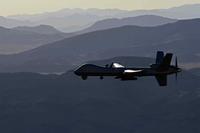 They may look a litle silly -- like giant volleyballs, kinda. But the Navy thinks that big, round blimps may just be the key to spying on terrorist camps, and communicating with its sailors.
They may look a litle silly -- like giant volleyballs, kinda. But the Navy thinks that big, round blimps may just be the key to spying on terrorist camps, and communicating with its sailors.
As we've mentioned before, the U.S. military has been on a bit of an airship kick, lately. That's because the helium-filled, lighter-than-air craft can stay in the skies a whole lot longer than fuel-eating jets. And that means the blimps could work as floating cell towers or observation posts.
Round airships have some advantages over their cigar-shaped cousins, said Hokan Colting, who designed the SA-60 spherical blimp for the Navy.
"It's more maneuverable than a traditional airship," Colting told Aerospace Daily. "It's amphibious, it can land and take off from water. And it can go to high altitudes. Traditional, cigar-shaped airships can go to 5,000-6,000 feet ... We have been up to 22,000 feet with [a spherical] airship, and that's the absolute world record in altitude for airships."
The SA-60 can be transported in a truck and set up by a small group of people in roughly 24 hours, according to the companies. Although it requires a pilot, the companies plan to make the airship unmanned to allow for longer flights...
The companies are developing a larger operational version of the SA-60 that would have a diameter of 76 feet, an operational ceiling of 16,000 feet, and a flight endurance of roughly two days. In 12 months, the companies plan to build a 200-foot diameter version that would be capable of wide-area surveillance or telecommunications relay at altitudes up to 65,000 feet.
But there are a whole lot of kinks to work out, first. When the SA-60 was tested recently by Naval Air Systems Command, the helium gas inside heated and expanded, making the vehicle extra buoyant and leaving it underweight. That made it a bitch to bring the orb back to earth.
Aerospace Daily dryly noted, "During some aborted landing attempts, the airship briefly contacted the ground and bounced like an enormous beach ball."
THERE'S MORE: "I know I'm nitpicking here," says Defense Tech reader GW, "but Hokan Colting needs to check his basic history on airships. World War I German airships routinely operated at 22,000 ft, and that was in 1916."
The only reason that American airships of the 20s and 30s operated with lower maximum ceilings was to conserve helium, an extremely expensive gas back then. At one time the U.S. only had enough gas to operate one of their 3 airships. German passenger zeppelins (which used cheap, plentiful hydrogen) operated at lower altitudes for the comfort of their passengers and for greater cargo lift capacity.
AND MORE: GW "is flat-out wrong. According to the Balloon & Airship World Records Homepage, the altitude record for an airship is 6,234 m or 20,453 feet and was made in June of 2003," says Defense Tech reader BP. "What GW may have been thinking of was a balloon altitude. According to the same site, the current altitude record for a balloon is 34,668 m or 113,740 feet which was made in 1961."







